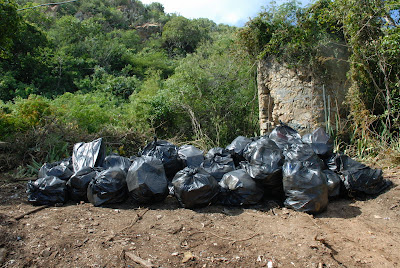At Cinnamon Bay, a tall ship sailing through Drake's Channel.

Season's Greetings. Ken, Kourtney, Katie, Amber and Susanna all wish everyone a very happy holiday and New Year. Ken was on the mainland for a week to attend the graduation of his daughter Lauren, who is receiving a bachelor of Environmental Science from Florida State University. We all want to congratulate Lauren on her accomplishment and wish here well in her future endeaevors. While Ken was away, some of the behind the scenes details were given our attention, such as environmental monitoring of the collection building, continuing research of the the human remains from Cinnamon Bay, conservation of the recently submerged artifacts and vegetation clearing. And Kourtney and Susanna had the pleasure of teaching 35 seventh graders about archeology and curation at the Cinnamon Bay Lab and future museum. Everyone had a great time and some important lessons were passed on, such as context, provenience, stratigraphy and the role of Hassel Island in the bid to purchase these islands from the Danes. In addition to learning about a real excavation from Kourtney, the students helped to wash several field sites Field Specimen ie(FS#'s) from the surveying at Careening Cove. Among the artifacts that were cleaned was a wide assortment of bottlenecks and glass bases. Although the kids were a big help and we enjoyed the group very much, we realized that we have a lot of work ahead of us in the cataloging of all the objects. In addition, we will need help from additional interns, so please continue to donate to the Friends in 2008, and thank you to all who donated in the past.

Students helping out with washing artifacts.

Seventh Graders from Sprauve School, Cruz Bay, St. John.
Hopefully, we can have Amber write the next posting about all her work in the lab with the conservation of the submerged metal. Stay tuned for some spectacular chemistry folks. Kourtney's work is also fascinating so when we all return from the Holidays be sure to check out the blog for updates.
This week, we recruited a new member to our team, NPS Wildlife Biologist Carrie Stengel. Carrie was instrumental in instructing the team on the proper use of herbicides that will curtail the growth of exotic and invasive species at the Creque Marine Railway. We really don't want to see this stucture covered in catch and keep for a very long time so it will take maintenance to keep the site open. Stay tuned for opportunities to help in the revitalization of the Creque Marine Slipway and other sites on Hassel Island.

View out of the winch house, Creque Marine.
Also on Hassel Island, the old iron wreck in Charlotte Amalie mentioned in the previous post is simply no match for Rocky, Toby and Chris from Seatow. Although the work is slow and dangerous, the Seatow crew is taking apart the ship piece by piece. (Unconfirmed sources report that this ship was commissioned by an infamous German leader during WWII.) The difference to the island from the beginning of November to now is truly remarkable, and thank you again to everyone that is helping to keep Hassel Island safe and secure for future generations.

Seatow's crewman Chris working on the awesome wreck.















 Brown Bay Ruins
Brown Bay Ruins.jpg) Josie's Gut Ruins
Josie's Gut Ruins
.jpg)


 It was a shiny piece of copper sheathing with one little tack still hanging from the corner.
It was a shiny piece of copper sheathing with one little tack still hanging from the corner.  The salt water had turned it gold, teal and pink and Ken said it was probably used to cover the bottom of a historic ship. After consulting with Peter Fix, an archaeologist and conservator at Texas A&M University, Ken found out that copper sheathing was used for the first time in 1761 to prevent marine worms from damaging the bottoms of wooden ships. The HMS Alarm was the first ship to recieve this form of protection. This date corresponds with several other artifacts that were recovered from the site in 2002 including a lead gaming peice and a pearlwear ceramic bowl rim shard.
The salt water had turned it gold, teal and pink and Ken said it was probably used to cover the bottom of a historic ship. After consulting with Peter Fix, an archaeologist and conservator at Texas A&M University, Ken found out that copper sheathing was used for the first time in 1761 to prevent marine worms from damaging the bottoms of wooden ships. The HMS Alarm was the first ship to recieve this form of protection. This date corresponds with several other artifacts that were recovered from the site in 2002 including a lead gaming peice and a pearlwear ceramic bowl rim shard.
 (me looking through a rusted out boiler at Hassel Island)
(me looking through a rusted out boiler at Hassel Island)
 (Randy and Lalo loading debris onto a platform)
(Randy and Lalo loading debris onto a platform)


 The marine rails were found to be well preserved underwater.
The marine rails were found to be well preserved underwater.



















